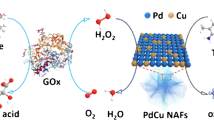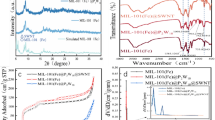Abstract
Nanozyme is a promising field that offers the substitution for natural enzymes using various nanomaterials. Various nanomaterials with peroxidase-like activity were investigated. Among them, transition metal chalcogenides were explored as promising nanozymes due to their excellent enzyme-mimicking activities. However, ruthenium selenide has not been studied as a peroxidase mimic because of the difficulty for synthesis. Herein, we prepared ruthenium selenide nanomaterial with ordered mesoporous structure (P-RuSe2) employing KIT-6 silica as the template. The composition and structure of P-RuSe2 were fully characterized. Further, its peroxidase-like activity was investigated. P-RuSe2 possessed excellent peroxidase-mimicking activity, which catalyzed the oxidation of peroxidase substrates, including 3,3′,5,5′-tetramethylbenzidine, o-phenylenediamine, and 2,2′-azino-bis(3-ethylbenzothiazoline-6-sulfonic acid) in the presence of H2O2. Moreover, P-RuSe2 exhibited higher peroxidase-like activity when compared with several representative nanozymes as well as bulk RuSe2. To demonstrate its potential applications, the colorimetric detection systems for H2O2 and glucose were successfully constructed based on P-RuSe2 nanozyme.





Similar content being viewed by others
References
Wu JJX, et al. Nanomaterials with enzyme-like characteristics (nanozymes): next-generation artificial enzymes (II). Chem Soc Rev. 2019;48:1004–76.
Breslow R. Biomimetic chemistry and artificial enzymes: catalysis by design. Acc Chem Res. 1995;28:146–53.
Gao LZ, et al. Intrinsic peroxidase-like activity of ferromagnetic nanoparticles. Nat Nanotechnol. 2007;2:577–83.
Wei H, et al. Nanomaterials with enzyme-like characteristics (nanozymes): next-generation artificial enzymes. Chem Soc Rev. 2013;42:6060–93.
Zhou YB, et al. Filling in the gaps between nanozymes and enzymes: challenges and opportunities. Bioconjugate Chem. 2017;28:2903–9.
Lin YH, et al. Catalytically active nanomaterials: a promising candidate for artificial enzymes. Acc Chem Res. 2014;47:1097–105.
Zhang XZ, et al. Bioorthogonal nanozymes: progress towards therapeutic applications. Trends Chem. 2019;1:90–8.
Yan XY. Nanozyme: a new type of artificial enzyme. Prog Biochem Biophys. 2018;45:101–4.
Fan KL, et al. Magnetoferritin nanoparticles for targeting and visualizing tumour tissues. Nat Nanotechnol. 2012;7:459–64.
Song YJ, et al. Graphene oxide: intrinsic peroxidase catalytic activity and its application to glucose detection. Adv Mater. 2010;22:2206–10.
Tonga GY, et al. Supramolecular regulation of bioorthogonal catalysis in cells using nanoparticle-embedded transition metal catalysts. Nat Chem. 2015;7:597–603.
Natalio F, et al. Vanadium pentoxide nanoparticles mimic vanadium haloperoxidases and thwart biofilm formation. Nat Nanotechnol. 2012;7:530–5.
Zhang ZJ, et al. Molecular imprinting on inorganic nanozymes for hundred-fold enzyme specificity. J Am Chem Soc. 2017;139:5412–9.
Soh M, et al. Ceria-zirconia nanoparticles as an enhanced multi-antioxidant for sepsis treatment. Angew Chem Int Ed. 2017;56:11399–403.
Chen JP, et al. Rare earth nanoparticles prevent retinal degeneration induced by intracellular peroxides. Nat Nanotechnol. 2006;1:142–50.
Vernekar AA, et al. An antioxidant nanozyme that uncovers the cytoprotective potential of vanadia nanowires. Nat Commun. 2014;5:5301.
Walther R, et al. Identification and directed development of non-organic catalysts with apparent pan-enzymatic mimicry into nanozymes for efficient prodrug conversion. Angew Chem Int Ed. 2019;58:278–82.
Sun MZ, et al. Site-selective photoinduced cleavage and profiling of DNA by chiral semiconductor nanoparticles. Nat Chem. 2018;10:821–30.
Fang G, et al. Differential Pd-nanocrystal facets demonstrate distinct antibacterial activity against Gram-positive and Gram-negative bacteria. Nat Commun. 2018;9:129.
Shen XM, et al. Mechanisms of oxidase and superoxide dismutation-like activities of gold, silver, platinum, and palladium, and their alloys: a general way to the activation of molecular oxygen. J Am Chem Soc. 2015;137:15882–91.
Zhang W, et al. Prussian blue nanoparticles as multienzyme mimetics and reactive oxygen species scavengers. J Am Chem Soc. 2016;138:5860–5.
Xu ZB, et al. Converting organosulfur compounds to inorganic polysulfides against resistant bacterial infections. Nat Commun. 2018;9:3713.
Wei H, et al. Fe3O4 magnetic nanoparticles as peroxidase mimetics and their applications in H2O2 and glucose detection. Anal Chem. 2008;80:2250–4.
Cheng HJ, et al. Integrated nanozymes with nanoscale proximity for in vivo neurochemical monitoring in living brains. Anal Chem. 2016;88:5489–97.
Hu YH, et al. Surface-enhanced raman scattering active gold nanoparticles with enzyme-mimicking activities for measuring glucose and lactate in living tissues. ACS Nano. 2017;11:5558–66.
Wang XY, et al. Boosting the peroxidase-like activity of nanostructured nickel by inducing its 3 + oxidation state in LaNiO3 perovskite and its application for biomedical assays. Theranostics. 2017;7:2277–86.
Cheng HJ, et al. Monitoring of heparin activity in live rats using metal-organic framework nanosheets as peroxidase mimics. Anal Chem. 2017;89:11552–9.
Hu YH, et al. Nitrogen-doped carbon nanomaterials as highly active and specific peroxidase mimics. Chem Mater. 2018;30:6431–9.
Qin L, et al. 2D-metal-organic-framework-nanozyme sensor arrays for probing phosphates and their enzymatic hydrolysis. Anal Chem. 2018;90:9983–9.
Wang XY, et al. Nanozyme sensor arrays for detecting versatile analytes from small molecules to proteins and cells. Anal Chem. 2018;90:11696–702.
Wang XY, et al. eg occupancy as an effective descriptor for the catalytic activity of perovskite oxide-based peroxidase mimics. Nat Commun. 2019;10:704.
Zhang WC, et al. Pd nanoparticle-decorated graphitic C3N4 nanosheets with bifunctional peroxidase mimicking and ON–OFF fluorescence enable naked-eye and fluorescent dual-readout sensing of glucose. J Mater Chem B. 2019;7:233–9.
Kong CJ, et al. Highly-active, graphene-supported platinum catalyst for the solventless hydrosilylation of olefins. Chem Commun. 2018;54:13343–6.
He YF, et al. A cobalt-based polyoxometalate nanozyme with high peroxidase-mimicking activity at neutral pH for one-pot colorimetric analysis of glucose. J Mater Chem B. 2018;6:5750–5.
Wang JJ, et al. Polyoxometalates as peroxidase mimetics and their applications in H2O2 and glucose detection. Biosens Bioelectron. 2012;36:18–21.
Huang LJ, et al. Portable colorimetric detection of Mercury (II) based on a non-noble metal nanozyme with tunable activity. Inorg Chem. 2019;58:1638–46.
Shi WB, et al. Carbon nanodots as peroxidase mimetics and their applications to glucose detection. Chem Commun. 2011;47:6695–7.
Vernekar AA, et al. Vacancy-engineered nanoceria: enzyme mimetic hotspots for the degradation of nerve agents. Angew Chem Int Ed. 2016;55:1412–6.
Wang QQ, et al. GOx@ ZIF-8 (NiPd) nanoflower: an artificial enzyme system for tandem catalysis. Angew Chem Int Ed. 2017;56:16082–5.
Wu YH, et al. Ultra-small particles of iron oxide as peroxidase for immunohistochemical detection. Nanotechnology. 2011;22:225703.
Dutta AK, et al. CuS nanoparticles as a mimic peroxidase for colorimetric estimation of human blood glucose level. Talanta. 2013;107:361–7.
Guan JF, et al. Synthesis of copper sulfide nanorods as peroxidase mimics for colorimetric detection of hydrogen peroxide. Anal Methods. 2015;7:5454–61.
He WW, et al. Understanding the formation of CuS concave superstructures with peroxidase-like activity. Nanoscale. 2012;4:3501–6.
Lin TR, et al. Visual detection of blood glucose based on peroxidase-like activity of WS2 nanosheets. Biosens Bioelectron. 2014;62:302–7.
Chen Q, et al. Hemin-functionalized WS2 nanosheets as highly active peroxidase mimetics for label-free colorimetric detection of H2O2 and glucose. Analyst. 2015;140:2857–63.
Bai Y, et al. Novel magnetic nickel telluride nanowires decorated with thorns: synthesis and their intrinsic peroxidase-like activity for detection of glucose. Chem Commun. 2014;50:13589–91.
Zhao K, et al. SDS-MoS2 nanoparticles as highly-efficient peroxidase mimetics for colorimetric detection of H2O2 and glucose. Talanta. 2015;141:47–52.
Lin TR, et al. Seeing diabetes: visual detection of glucose based on the intrinsic peroxidase-like activity of MoS2 nanosheets. Nanoscale. 2014;6:11856–62.
Wang WJ, et al. Synthesis of Au-WS2 nanocomposites and study on its peroxidase mimic activity. Chin J Anal Chem. 2018;46:1545–51.
Niu XH, et al. Uncapped nanobranch-based CuS clews used as an efficient peroxidase mimic enable the visual detection of hydrogen peroxide and glucose with fast response. Anal Chim Acta. 2016;947:42–9.
Ye HH, et al. Peroxidase-like properties of ruthenium nanoframes. Sci Bull. 2016;61:1739–45.
Deng HM, et al. Nanoparticulate peroxidase/catalase mimetic and its application. Chem Eur J. 2012;18:8906–11.
Xia XH, et al. Pd-Ir core-shell nanocubes: a type of highly efficient and versatile peroxidase mimic. ACS Nano. 2015;9:9994–10004.
Jang JH, et al. Superior oxygen electrocatalysis on RuSex nanoparticles for rechargeable air cathodes. Adv Energy Mater. 2018;8:1702037.
Cai HY, et al. Bifacial dye-sensitized solar cells with enhanced rear efficiency and power output. Nanoscale. 2014;6:15127–33.
Li PJ, et al. Counter electrodes from binary ruthenium selenide alloys for dye-sensitized solar cells. J Power Sources. 2014;271:108–13.
Guo YJ, et al. Hemin-graphene hybrid nanosheets with intrinsic peroxidase-like activity for label-free colorimetric detection of single-nucleotide polymorphism. ACS Nano. 2011;5:1282–90.
Chaudhari KN, et al. Peroxidase mimic activity of hematite iron oxides (α-Fe2O3) with different nanostructures. Catal Sci Technol. 2012;2:119–24.
Liu BW, et al. Accelerating peroxidase mimicking nanozymes using DNA. Nanoscale. 2015;7:13831–5.
Zhang XQ, et al. Prussian blue modified iron oxide magnetic nanoparticles and their high peroxidase-like activity. J Mater Chem. 2010;20:5110–6.
Kleitz F, et al. Cubic Ia3d large mesoporous silica: synthesis and replication to platinum nanowires, carbon nanorods and carbon nanotubes. Chem Commun. 2003;17:2136–7.
Shen J, et al. An ESCA study of the interaction of oxygen with the surface of ruthenium. Appl Surf Sci. 1991;51:47–60.
Li HY, et al. Simple microwave preparation of high activity Se-rich CoSe2/C for oxygen reduction reaction. Electrochim Acta. 2014;138:232–9.
Acknowledgements
This work was supported by National Natural Science Foundation of China (21874067 and 21722503), 973 Program (2015CB659400), PAPD program, Shuangchuang Program of Jiangsu Province, Open Funds of the State Key Laboratory of Analytical Chemistry for Life Science (SKLACLS1704), Open Funds of the State Key Laboratory of Coordination Chemistry (SKLCC1819), Key Laboratory of Analytical Chemistry for Biology and Medicine (Ministry of Education) (ACBM2019001), and Fundamental Research Funds for the Central Universities (021314380145).
Author information
Authors and Affiliations
Corresponding author
Electronic supplementary material
Below is the link to the electronic supplementary material.
About this article
Cite this article
Cao, W., Lin, J., Muhammad, F. et al. Porous Ruthenium Selenide Nanoparticle as a Peroxidase Mimic for Glucose Bioassay. J. Anal. Test. 3, 253–259 (2019). https://doi.org/10.1007/s41664-019-00104-0
Received:
Accepted:
Published:
Issue Date:
DOI: https://doi.org/10.1007/s41664-019-00104-0




